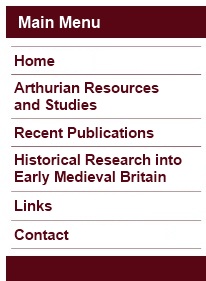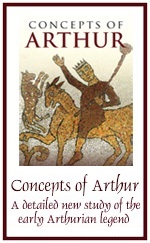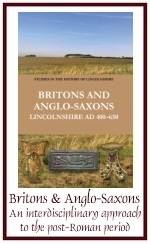
 |

|
The Historical Research section of this website offers details of some of my research into the history of early medieval Britain, c. AD 400-850. This research tends to be interdisciplinary in nature, making use of the available archaeological, historical, literary and linguistic evidence. A major focus has been on post-Roman period, which is dealt with in detail in my recent academic monograph, Britons and Anglo-Saxons. However, I am also interested more generally in the place-names, archaeology and history of pre-Viking Britain, and in the medieval literature which purports to tell of events in this period. Some of my main research interests and a selection of the topics that I have worked on recently are outlined below, along with details of the relevant publications (largely written under a former nom de plume). A British Polity in the Lincoln Region There is now a significant body of evidence to suggest that the former Late Roman provincial capital of Lincoln retained its centrality into the post-Roman period, becoming the focus of a British polity known as *Lindēs. This polity was eventually taken over by the Anglo-Saxon immigrants to this region to become the seventh-century kingdom of Lindissi (a name that derives from *Lindēs), but as a British political territory it probably survived right the way through the fifth century and at least some way into the sixth. There is, for example, a remarkable quantity of British high-status metalwork of the fifth and sixth centuries now known from Lincolnshire, and the old Roman forum at Lincoln looks to have been used as the site for a British Christian church during the fifth and sixth centuries. Most importantly, this fifth- to sixth-century British polity appears to have been able to control the Anglo-Saxon immigrants who arrived in its territory, with this control only seeming to break down after the early sixth century. See Further: Green, Britons and Anglo-Saxons: Lincolnshire AD 400-650 (History of Lincolnshire Committee, 2012), especially chapters 2 and 3; Green, 'The British Kingdom of Lindsey', Cambrian Medieval Celtic Studies, 56 (2008), 1-43; Green, A Re-evaluation of the Evidence of Anglian-British Interaction in the Lincoln Region (Oxford D.Phil Thesis, 2011); Green, 'Tealby, the Taifali, and the End of Roman Lincolnshire', in Lincolnshire History & Archaeology, 46 (2011 [2014]), pp. 5-10. The Origins of Anglo-Saxon Kingdoms and Anglian-British Interaction in the Fifth to Eighth Centuries. A full interdisciplinary investigation of the evidence from the Anglo-Saxon kingdom of Lindissi (which originally covered not only much of modern Lincolnshire, both to the north and south of Lincoln, but also parts of the surrounding counties) and the wider pre-Viking Lincoln region has potentially important implications for our understanding of the origins of Anglo-Saxon kingdoms and the nature of Anglian-British interaction in the Early Anglo-Saxon and Middle Saxon periods. In particular, such an investigation suggests: (1) that the common model of Anglo-Saxon kingdoms being created anew in the sixth and seventh centuries as a result of the unification of much smaller, independent Anglo-Saxon groups and peoples cannot be seen to credibly apply in the Lincoln region, despite this being one of the areas of eastern Britain with the most evidence for fifth- and earlier sixth-century Anglo-Saxon immigration. Instead, as is noted above, there appears to have been a significant degree of political continuity in this area. Most especially, there is strong evidence to indicate that the Late Roman provincial capital of Lincoln continued to control a large territory well into the post-Roman era, with the seventh-century Anglo-Saxon kingdom of Lindissi being intimately connected to this British territory and not, in fact, a new 'Germanic' polity formed from the ground up at all; (2) that there was a significant and noteworthy British component both within the population of the Lincoln region and underlying its political, administrative and cultural life and geography during the Early Anglo-Saxon and Middle Saxon periods, with the absorption and acculturation of the British element in the region's population continuing into the eighth century; and (3) that there seems little reason to believe that the small Anglo-Saxon groups that can be identified in this region, both inside and outside of Lindissi (such as the Billingas, the Spalde and Gyrwe), were ever truly independent 'peoples' and 'proto-kingdoms', rather than simply being always sub-groups within larger political units, contrary to the usual model of Anglo-Saxon kingdom formation. See Further: Green, Britons and Anglo-Saxons: Lincolnshire AD 400-650 (History of Lincolnshire Committee, 2012), especially chapters 1-5; Green, 'The British Kingdom of Lindsey', Cambrian Medieval Celtic Studies, 56 (2008), 1-43; Green, A Re-evaluation of the Evidence of Anglian-British Interaction in the Lincoln Region (Oxford D.Phil Thesis, 2011). Anglo-Saxon population groups, meeting-places, territories and administrative units Although the documentary record of pre-Viking population-groups, territories (regiones) and administrative units within the Lincoln region is poor compared to some other parts of Anglo-Saxon England, the use of an interdisciplinary approach allows a number of groups to be fairly confidently identified, delineated and analysed in this area. For example, the Billingas emerge from such an analysis as a south Lincolnshire, fen-edge population group centred on Sleaford-Quarrington,which occupied a large territory that probably lay within the southern part of the kingdom of Lindissi and which had a major trading site at Garwick. In general, an analysis of all the available evidence indicates that these groups and territories are likely to have always been sub-groups or administrative districts, rather than previously independent polities; that each of the major cremation cemeteries of the region probably acted as central places for early groups and territories; that many of the identifiable pre-Viking sub-groups and their suggested territories show signs of probable or possible continuity with the British past; and that aspects of the Anglo-Scandinavian administrative structure of the tenth- and eleventh-century Lincoln region appear to have had their origins in the pre-Viking period and arguably in the Early Anglo-Saxon period or before. With regard to the latter point, a number of the Anglo-Scandinavian wapentakes of Lincolnshire can, for example, be credibly seen as either potentially having such early origins or, alternatively, resulting from the sub-division of early, larger territories, whilst the meeting place of Anglo-Scandinavian Lindsey at Lissingleys could well have its origins in the Romano-British era or even before. See Further: Green, Britons and Anglo-Saxons: Lincolnshire AD 400-650 (History of Lincolnshire Committee, 2012), especially pp. 136-47 and 163-234; Green, 'The British Kingdom of Lindsey', Cambrian Medieval Celtic Studies, 56 (2008), 1-43; Green, A Re-evaluation of the Evidence of Anglian-British Interaction in the Lincoln Region (Oxford D.Phil Thesis, 2011). The Origins of Lindisfarne and the Kingdom of Bernicia A combination of linguistic, historical and archaeological evidence indicates that the important Anglo-Saxon kingdom of Northumbria may well have had its roots in Anglian groups based in the Lincoln region, with the kingdom of Mercia possibly possessing similar connections too. Such ties to the Lincoln region offer a potential partial explanation for the seventh-century political priorities of these major kingdoms and the deep interest that they had in controlling the Lincoln region. With specific regard to Northumbria, and most especially the northern part of it known as Bernicia, the place-name 'Lindisfarne' is key. A variety of Archaic Irish, Archaic Welsh and Old English etymologies and interpretations have been proposed for Lindisfarne (Old English Lindisfarena ea). There are, however, sound historical and linguistic reasons for dismissing all of these solutions except for the most obvious, that Lindisfarena ea is an Old English place-name meaning 'the island of the Lindisfaran'. The most credible interpretation of this etymology for Lindisfarne is that the island was originally settled by Anglo-Saxon migrants from Lincolnshire (the Lindisfaran were a major Anglo-Saxon population-group based in the Lincoln region), and such a scenario can be shown to have a good historical and archaeological context in the region and more widely. Moreover, it can be argued that the arrival of the Lindisfaran here could well have been identical with the arrival of either the founders of the kingdom of Bernicia or the ancestors of the same, with the Bernician kings going to be the rulers of the Northumbrian kingdom. See Further: Green, Britons and Anglo-Saxons: Lincolnshire AD 400-650 (History of Lincolnshire Committee, 2012), especially pp. 150-4, 235-65; Green, 'Lindisfarne and Lindsey', Anglo-Saxon, 2 (tbc), 1-19 [peer-reviewed and fully proofed, awaiting publication]; Green, A Re-evaluation of the Evidence of Anglian-British Interaction in the Lincoln Region (Oxford D.Phil Thesis, 2011). Metal-Detecting, Place-Names & Anglo-Saxon History An interdisciplinary approach to the pre-Viking period (c. AD 450-850) arguably allows for significant advances in our understanding of this era to be made, and place-names and the ever-growing corpus of metal-detected material are both key from this perspective. Place-names have tremendous potential for enhancing our understanding of the era, especially if used in concert with the written and archaeological records, and names such as Lindisfarne, Tealby and Lindsey form a fundamental part of the corpus of evidence used throughout Britons and Anglo-Saxons and in other publications (see above, for example, on the potential significance of the place-name Lindisfarne). Similarly, metal-detected material offers us the ability to fill in the many lacunae left by more traditional archaeological methods and the haphazard preservation of written materials. For example, it can be used to correct the impression that there was virtually no Early Anglo-Saxon activity in the southern third of Lincolnshire and it helps to deliminate the territory of the Billingas. Metal-detected finds also reveal significant and previously unsuspected sites that can have tremendous historical significance. Thus the metal-detected assemblage from Lissingleys strongly supports the notion that the origins of this Anglo-Scandinavian meeting-place site for the whole of Lindsey may lie in the Early Anglo-Saxon or Romano-British periods. Even more importantly, metal-detecting has revealed that there was an important Anglo-Saxon trading site (wīc) at Garwick, Heckington, in southern Lincolnshire, which has the highest concentration of non-hoarded Middle Saxon coinage outside of that at Hamwic (Southampton). Indeed, this site, put in its proper context, can allow us to understand key aspects of the history of this region that might otherwise remain opaque. See Further: Green, Britons and Anglo-Saxons: Lincolnshire AD 400-650 (History of Lincolnshire Committee, 2012), passim but especially pp. 136-45 and 185-200 on Lissingleys and Garwick; Green, 'The British Kingdom of Lindsey', Cambrian Medieval Celtic Studies, 56 (2008), 1-43; Green, 'Tealby, the Taifali, and the End of Roman Lincolnshire', in Lincolnshire History & Archaeology, 46 (2011 [2014]), pp. 5-10; Green, 'Lindisfarne and Lindsey', Anglo-Saxon, 2 (tbc), 1-19 [peer-reviewed and fully proofed, awaiting publication]; Green, A Re-evaluation of the Evidence of Anglian-British Interaction in the Lincoln Region (Oxford D.Phil Thesis, 2011). Imports and Romanitas in South-Western Britain and Scandinavia The archaeology of both post-Roman western Britain and southern Scandinavia in the Late Roman Iron Age reveals a degree of continuous directed trading taking place between these areas and the Roman Empire. Whilst there are significant differences between these two regions and in the nature of their Roman trade, in both cases the goods involved are clearly luxuries for the cultures in which they are found. Moreover, this trade and its imports appear to have been securely in the control of the highest elites in the respective regions. These seem to have been consciously trying to appear Roman in their usage of these items (thus securing their position in society), and the general distribution of the imports in both regions implies the redistribution of these items by the elites to their retainers, in an attempt to secure and consolidate their control over a wider region. The political importance of the imports is potentially demonstrated by the collapse in the social structure of the kingdom of Dumnonia when the trade in these items suddenly ceases. See Further: Green, 'Trade, Gift-Giving and Romanitas: A Comparison of the Use of Roman Imports in Western Britain and Southern Scandinavia', The Heroic Age: A Journal of Early Medieval Northwestern Europe, 10 (May 2007). * * * * * Copyright © 2011, 2014 Caitlin R. Green. All Rights Reserved. To cite articles or pages from this website, use a service such as WebCite or alternatively see one of the following style citation guides. Questions and queries via email to Caitlin R. Green. |
   |